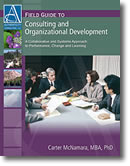Basic Context for Organizational Change
© Copyright Carter McNamara, MBA, PhD, Authenticity Consulting, LLC, experts in organizational change.
It seems like the topic of organizational change has reached evangelical proportions. There’s an explosion of literature about the subject and an accompanying explosion in the number of consultants who offer services in this general area. The following information attempts to provide some basic perspective about the concept of organizational change. (See the and listed at the end of this article.)
Sections of This Topic Include
- What’s “Organizational Change?”
- What Provokes Organizational Change?
- Why is Organization-Wide Change Difficult to Accomplish?
- How Is Organization-Wide Change Best Carried Out?
- Some General Guidelines for Organization-Wide Change
- Additional Perspectives on Organizational Change
Also consider
Related Library Topics
Learn More in the Library’s Blog Related to Organizational Change (Change Management)
In addition to the articles on this current page, see the following blog which has posts related to Organizational Change (Change Management). Scan down the blog’s page to see various posts. Also see the section “Recent Blog Posts” in the sidebar of the blog or click on “next” near the bottom of a post in the blog.
What’s “Organizational Change?”
Typically, the concept of organizational change is in regard to organization-wide change, as opposed to smaller changes such as adding a new person, modifying a program, etc. Examples of organization-wide change might include a change in mission, restructuring operations (e.g., restructuring to self-managed teams, layoffs, etc.), new technologies, mergers, major collaborations, “rightsizing”, new programs such as Total Quality Management, re-engineering, etc. Some experts refer to organizational transformation. Often this term designates a fundamental and radical reorientation in the way the organization operates.
What Provokes “Organizational Change”?
Change should not be done for the sake of change — it’s a strategy to accomplish some overall goal. (See Organizational Performance Management.) Usually organizational change is provoked by some major outside driving force, e.g., substantial cuts in funding, address major new markets/clients, need for dramatic increases in productivity/services, etc. Typically, organizations must undertake organization-wide change to evolve to a different level in their life cycle, e.g., going from a highly reactive, entrepreneurial organization to more stable and planned development. Transition to a new chief executive can provoke organization-wide change when his or her new and unique personality pervades the entire organization.
Why is Organization-Wide Change Difficult to Accomplish?
Typically there are strong resistances to change. People are afraid of the unknown. Many people think things are already just fine and don’t understand the need for change. Many are inherently cynical about change, particularly from reading about the notion of “change” as if it’s a mantra. Many doubt there are effective means to accomplish major organizational change. Often there are conflicting goals in the organization, e.g., to increase resources to accomplish the change yet concurrently cut costs to remain viable. Organization-wide change often goes against the very values held dear by members in the organization, that is, the change may go against how members believe things should be done. That’s why much of organizational-change literature discusses needed changes in the culture of the organization, including changes in members’ values and beliefs and in the way they enact these values and beliefs.
How Is Organization-Wide Change Best Carried Out?
Successful change must involve top management, including the board and chief executive. Usually there’s a champion who initially instigates the change by being visionary, persuasive and consistent. A change agent role is usually responsible to translate the vision to a realistic plan and carry out the plan. Change is usually best carried out as a team-wide effort. Communications about the change should be frequent and with all organization members. To sustain change, the structures of the organization itself should be modified, including strategic plans, policies and procedures. This change in the structures of the organization typically involves an unfreezing, change and re-freezing process.
The best approaches to address resistances is through increased and sustained communications and education. For example, the leader should meet with all managers and staff to explain reasons for
the change, how it generally will be carried out and where others can go for additional information. A plan should be developed and communicated. Plans do change. That’s fine, but communicate that the plan has changed and why. Forums should be held for organization members to express their ideas for the plan. They should be able to express their concerns and frustrations as well.
Some General Guidelines to Organization-Wide Change
(Note that the library topic Basic Overview of Major Methods and Movements to Improve Organizational Performance includes overviews of major methods and movements associated with organizational change. Readers would best be served to read the following basic guidelines as foundation for carrying
out any of the methods associated with organizational change.)
In addition to the general guidelines listed above, there are a few other basic guidelines to keep in mind.
1. Consider using a consultant. Ensure the consultant is highly experienced in organization-wide change. Ask to see references and check the references.
2. Widely communicate the potential need for change. Communicate what you’re doing about it. Communicate what was done and how it worked out.
3. Get as much feedback as practical from employees, including what they think are the problems and what should be done to resolve them. If possible, work with a team of employees to manage the change.
4. Don’t get wrapped up in doing change for the sake of change. Know why you’re making the change. What goal(s) do you hope to accomplish?
6. Plan the change. How do you plan to reach the goals, what will you need to reach the goals, how long might it take and how will you know when you’ve reached your goals or not? Focus on the coordination of the departments/programs in your organization, not on each part by itself. Have someone in charge of the plan.
7. End up having every employee ultimately reporting to one person, if possible, and they should know who that person is. Job descriptions are often complained about, but they are useful in specifying who reports to whom.
8. Delegate decisions to employees as much as possible. This includes granting them the authority and responsibility to get the job done. As much as possible, let them decide how to do the project.
9. The process won’t be an “aha!” It will take longer than you think.
10. Keep perspective. Keep focused on meeting the needs of your customer or clients.
11. Take care of yourself first. Organization-wide change can be highly stressful.
12. Don’t seek to control change, but rather to expect it, understand it and manage it.
13. Include closure in the plan. Acknowledge and celebrate your accomplishments.
14. Read some resources about organizational change, including new forms and structures.
Additional Perspectives on Organizational Change
For the Category of Management:
To round out your knowledge of this Library topic, you may want to review some related topics, available from the link below. Each of the related topics includes free, online resources.
Also, scan the Recommended Books listed below. They have been selected for their relevance and highly practical nature.
 Sections of this topic
Sections of this topic

















